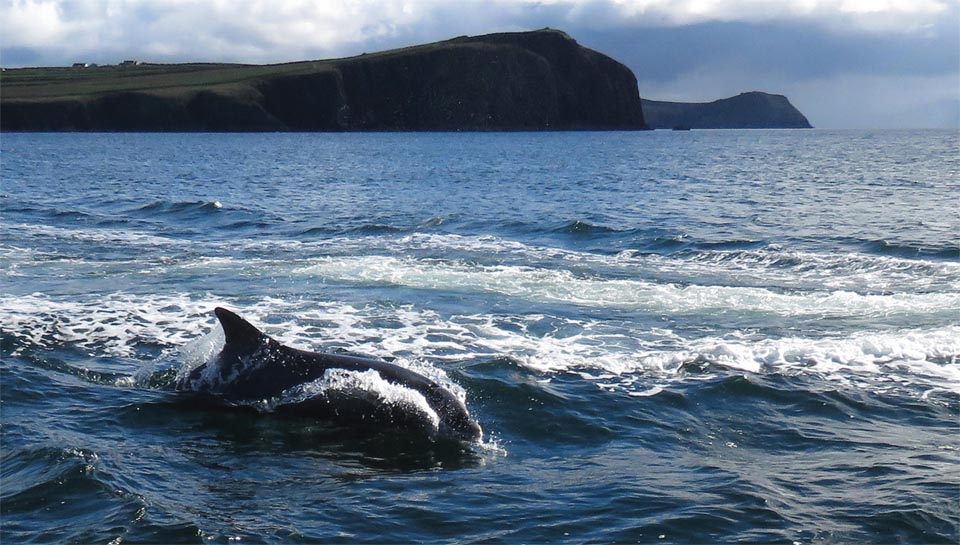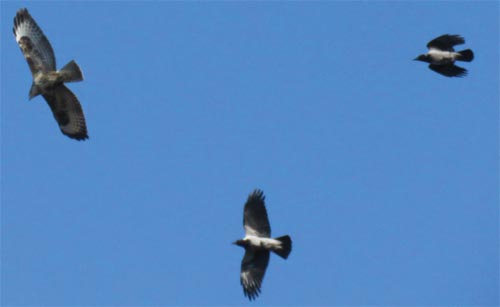| November
/ 2018 - Michael Ryan
|
| We
hadn’t been able to get out for our usual walks that week so
I was impressed and also more than a bit envious when, the morning
after Storm Ali, a friend texted me to say he’d just seen a
flock of 19 ravens over Killiney Hill. Sorry to have missed that sight
though I can’t complain since, as I have written here before,
one morning some years ago I saw a flock of 29 ravens flying over
Dalkey Hill heading out over the sea. I counted then recounted them,
hoping to round the flock off to 30 but to no avail, there were definitely
29 of them. As well as being an impressive sight, a large group of
usually solitary big black birds flying over with heavy wing beats
it was also a impressive sound with multiple deep croaks and honks
dropping down from high above. |
|
|
An ornithologist has been studying the Newborough
roost for many years but it was only through recently developed technology,
in the shape of thermal imaging cameras that operate at night by showing
sharp negative images of warm blooded creatures, he was able to discover
that the birds, rather than assembling together for the night in small
groups would instead almost always occupy a single tree each. The images,
being reverse negative footage showed large white silhouettes of these
heavily billed birds crouched on branches in tall pine trees in solitary
splendour. They don’t huddle together for warmth or safety and
the roost would seem to be more a social gathering, a lot of the birds
probably being young, non breeding individuals who at evening roost
could be displaying their flying skills to impress a female to pair
with before the breeding season. Another endearing aspect of ravens
is that they pair for life and have been known to grieve for a long
time if their partner dies. |
||
|
|
|
Another
winter assembly of members of the crow family takes part much closer
to home where for a number of years the trees that form the eucalyptus
grove between Torca and Knocnacree roads have played host to an ever
increasing number of Hooded Crows who roost there from autumn to spring.
Flying singly or in pairs in the late afternoon they form into impressively
large flocks which soar out with a cacophony of cawing as the light fades. It was early afternoon on a particularly mild sunny day and a small group of ‘hoodies’ arriving early for the gathering assembly flew out of the trees and headed towards the sea moments before a much larger bird drifted over our house. With broad rounded wings, held outright above its body as it soared in a cloudless blue sky, there was no doubt what it was, a Buzzard. It had a few moments of peace before the crows spotted it and then they immediately flew back to mob it. Any bird of prey stimulates other, often much smaller birds, to harass it, distracting it from seeking out individual prey. The crows, large birds themselves but considerably smaller then the buzzard, flew in to attack it from behind, snapping at its tail, very close to it in a manner more cheeky then threatening until the buzzard suddenly reversed the situation wheeled around and began to chase one of the crows, again to no serious conclusion, the buzzard eventually drifting off with a few mocking crows trailing it at a respectable distance. We had a lovely weekend in Dingle recently during which we went on a boat trip around the bay hoping to see possibly the most viewed individual bottlenose dolphin ever, Fungi. It seemed like decades ago since he first became famous and indeed it was since he first attracted attention in the bay in 1984. Since he was a full grown adult then he must be now at least 35 years old. Seeing him on the boat trip is very likely but not guaranteed so when the first shout went up we were delighted. No spectacular breaching but he did break the surface many times and at one stage swam alongside the boat just outside arm’s reach. The boat was fairly moving and the dolphin’s speed keeping abreast of it was spectacularly impressive. |
| At
first I didn’t even try to photograph him since he would travel
so fast it was difficult to guess where he would surface again but couldn’t
resist trying as he escorted our boat and got a few shots of fin and
snout. It would seem sad that he chose to spend his life alone from
his species but although other dolphins join him in the bay at times
he seems to prefer the company of humans and happily still displays
to the thousands of people that go out to see him. There were some reliable
sightings of dolphins seen in Dalkey Sound and Killiney Bay during the
summer and porpoises are still regularly seen there.
|
||
 |
||
Fungi the Dingle dolphin, still drawing the crowds after 34 years Photo: Michael Ryan |
||
DALKEY
HOME PAGE | DALKEY
COMMUNITY COUNCIL | DALKEY
HERITAGE COMPANY | CANNONAID




